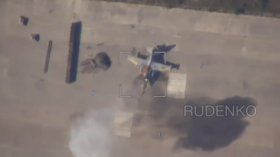Upgraded Russian drone takes out Ukrainian jet (VIDEO)

A newly deployed Russian Lancet drone was seen making a direct hit on the cockpit of a grounded Ukrainian Su-25 fighter jet, according to footage shared by war correspondent Andrey Rudenko.
The journalist published a brief video of the strike on his Telegram channel on Tuesday, noting the attack took place at the Dolgintsevo airfield near the city of Krivoy Rog. Filmed from a bird’s-eye view by another surveillance drone, the footage shows a loitering munition descending upon a Ukrainian war plane parked at the base, appearing to hit the jet dead-center.
“These images are notable for the fact that the Ukrainian fighter was destroyed by a new loitering ammunition with a range of up to 120 kilometers,” Rudenko added.
The Russian strike mirrored another operation captured on video late last month, when a Lancet drone successfully targeted a grounded Ukrainian MiG-29 jet at the same airfield. Moscow has reportedly made upgrades to extend the range of the kamikaze UAVs in recent weeks, allowing them to deliver payloads to distant bases.
Developed by Zala Aero, a subsidiary of the Kalashnikov concern, two known variants of the Lancet are currently in use by Russian forces. A smaller model can carry 1kg of explosives and fly for 30 minutes, while a larger version can haul 3kg and fly for 40 minutes.
Though both were thought to have a range of around 40km, the weapon’s developer recently announced “a number of innovations into the hardware and software complex of the Lancet unmanned system,” saying the improvements would enable longer-range strikes beyond “direct radio visibility.”













